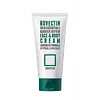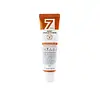What's inside
What's inside
 Key Ingredients
Key Ingredients

 Benefits
Benefits

 Concerns
Concerns

 Ingredients Side-by-side
Ingredients Side-by-side

Water
Skin ConditioningGlycerin
HumectantCaprylic/Capric Triglyceride
MaskingButylene Glycol
HumectantPanthenol
Skin ConditioningPalmitic Acid
EmollientStearic Acid
CleansingHydrogenated Poly(C6-14 Olefin)
EmollientLimnanthes Alba Seed Oil
Skin Conditioning1,2-Hexanediol
Skin ConditioningCeramide NP
Skin ConditioningTocopherol
AntioxidantAstaxanthin
Skin ConditioningPrunus Persica Kernel Oil
EmollientEclipta Prostrata Extract
Skin ConditioningMelia Azadirachta Flower Extract
Skin ConditioningMelia Azadirachta Leaf Extract
Skin ConditioningCurcuma Longa Root Extract
MaskingOcimum Sanctum Leaf Extract
Skin ConditioningCorallina Officinalis Extract
Skin ConditioningMoringa Oleifera Seed Oil
EmollientHydrogenated Vegetable Oil
EmollientHaematococcus Pluvialis Extract
AntioxidantPolyglyceryl-3 Methylglucose Distearate
EmulsifyingPolymethylsilsesquioxane
Pentylene Glycol
Skin ConditioningTromethamine
BufferingAcrylates/C10-30 Alkyl Acrylate Crosspolymer
Emulsion StabilisingCaprylyl Glycol
EmollientEthylhexylglycerin
Skin ConditioningSodium Phytate
Hydrogenated Lecithin
EmulsifyingWater, Glycerin, Caprylic/Capric Triglyceride, Butylene Glycol, Panthenol, Palmitic Acid, Stearic Acid, Hydrogenated Poly(C6-14 Olefin), Limnanthes Alba Seed Oil, 1,2-Hexanediol, Ceramide NP, Tocopherol, Astaxanthin, Prunus Persica Kernel Oil, Eclipta Prostrata Extract, Melia Azadirachta Flower Extract, Melia Azadirachta Leaf Extract, Curcuma Longa Root Extract, Ocimum Sanctum Leaf Extract, Corallina Officinalis Extract, Moringa Oleifera Seed Oil, Hydrogenated Vegetable Oil, Haematococcus Pluvialis Extract, Polyglyceryl-3 Methylglucose Distearate, Polymethylsilsesquioxane, Pentylene Glycol, Tromethamine, Acrylates/C10-30 Alkyl Acrylate Crosspolymer, Caprylyl Glycol, Ethylhexylglycerin, Sodium Phytate, Hydrogenated Lecithin
Water
Skin ConditioningGlycerin
HumectantNiacinamide
SmoothingDipropylene Glycol
HumectantAmmonium Acryloyldimethyltaurate/Vp Copolymer
Butyrospermum Parkii Butter
Skin ConditioningHelianthus Annuus Seed Oil
EmollientVitis Vinifera Seed Oil
EmollientGlycyrrhiza Glabra Root Extract
BleachingCimicifuga Racemosa Root Extract
AntimicrobialPolygonum Multiflorum Root Extract
Skin ConditioningSesamum Indicum Seed Extract
Skin ConditioningPhellinus Linteus Extract
Skin ConditioningAngelica Gigas Root Extract
Skin ConditioningMorus Alba Bark Extract
Skin ConditioningPaeonia Lactiflora Root Extract
Skin ConditioningSophora Flavescens Root Extract
AntioxidantScutellaria Baicalensis Root Extract
AstringentAnanas Sativus Fruit Water
Skin ConditioningAnanas Sativus Fruit Extract
Skin ConditioningAnanas Sativus Fruit Juice
Skin ConditioningCitrus Aurantium Dulcis Fruit Extract
MaskingCoptis Japonica Extract
AntimicrobialAscorbyl Glucoside
AntioxidantAscorbyl Tetraisopalmitate
AntioxidantTocopheryl Acetate
AntioxidantPanthenol
Skin ConditioningGlutathione
Astaxanthin
Skin ConditioningFullerenes
AntimicrobialFerulic Acid
AntimicrobialCeramide NP
Skin ConditioningButylene Glycol
HumectantPentylene Glycol
Skin ConditioningSodium Hyaluronate
HumectantHydrogenated Lecithin
EmulsifyingHydrolyzed Glycosaminoglycans
HumectantBeta-Glucan
Skin ConditioningBetaine
HumectantAllantoin
Skin ConditioningAdenosine
Skin ConditioningBeeswax
Emulsion StabilisingSqualane
EmollientCaprylic/Capric Triglyceride
MaskingPolyglyceryl-10 Diisostearate
EmulsifyingC12-13 Pareth-9
EmulsifyingPvp
Emulsion StabilisingSclerotium Gum
Emulsion Stabilising1,2-Hexanediol
Skin ConditioningBenzyl Glycol
SolventEthylhexylglycerin
Skin ConditioningRaspberry Ketone
MaskingCitrus Aurantium Dulcis Peel Oil
MaskingWater, Glycerin, Niacinamide, Dipropylene Glycol, Ammonium Acryloyldimethyltaurate/Vp Copolymer, Butyrospermum Parkii Butter, Helianthus Annuus Seed Oil, Vitis Vinifera Seed Oil, Glycyrrhiza Glabra Root Extract, Cimicifuga Racemosa Root Extract, Polygonum Multiflorum Root Extract, Sesamum Indicum Seed Extract, Phellinus Linteus Extract, Angelica Gigas Root Extract, Morus Alba Bark Extract, Paeonia Lactiflora Root Extract, Sophora Flavescens Root Extract, Scutellaria Baicalensis Root Extract, Ananas Sativus Fruit Water, Ananas Sativus Fruit Extract, Ananas Sativus Fruit Juice, Citrus Aurantium Dulcis Fruit Extract, Coptis Japonica Extract, Ascorbyl Glucoside, Ascorbyl Tetraisopalmitate, Tocopheryl Acetate, Panthenol, Glutathione, Astaxanthin, Fullerenes, Ferulic Acid, Ceramide NP, Butylene Glycol, Pentylene Glycol, Sodium Hyaluronate, Hydrogenated Lecithin, Hydrolyzed Glycosaminoglycans, Beta-Glucan, Betaine, Allantoin, Adenosine, Beeswax, Squalane, Caprylic/Capric Triglyceride, Polyglyceryl-10 Diisostearate, C12-13 Pareth-9, Pvp, Sclerotium Gum, 1,2-Hexanediol, Benzyl Glycol, Ethylhexylglycerin, Raspberry Ketone, Citrus Aurantium Dulcis Peel Oil
Ingredients Explained
These ingredients are found in both products.
Ingredients higher up in an ingredient list are typically present in a larger amount.
1,2-Hexanediol is a synthetic liquid and another multi-functional powerhouse.
It is a:
- Humectant, drawing moisture into the skin
- Emollient, helping to soften skin
- Solvent, dispersing and stabilizing formulas
- Preservative booster, enhancing the antimicrobial activity of other preservatives
Astaxanthin is a carotene pigment and red pigment. It is a promising antioxidant with a ton of skin benefits.
This antioxidant has great anti-aging benefits by blocking the following:
Astaxanthin is also great at soothing skin due to its ability to block molecules that signal inflammation. It is currently being studied for preventing chronic inflammatory diseases.
Plus, a study from 2012 found Astaxanthin in liposomes protected mouse skin from UV-damage.
Fun fact: Astaxanthin is responsible for giving salmon a pink color.
Learn more about AstaxanthinButylene Glycol (or BG) is used within cosmetic products for a few different reasons:
Overall, Butylene Glycol is a safe and well-rounded ingredient that works well with other ingredients.
Though this ingredient works well with most skin types, some people with sensitive skin may experience a reaction such as allergic rashes, closed comedones, or itchiness.
Learn more about Butylene GlycolThis ingredient is an emollient, solvent, and texture enhancer. It is considered a skin-softener by helping the skin prevent moisture loss.
It helps thicken a product's formula and makes it easier to spread by dissolving clumping compounds.
Caprylic Triglyceride is made by combining glycerin with coconut oil, forming a clear liquid.
While there is an assumption Caprylic Triglyceride can clog pores due to it being derived from coconut oil, there is no research supporting this.
Learn more about Caprylic/Capric TriglycerideCeramide NP is a type of ceramide.
Ceramides are intercellular lipids naturally found in our skin that bonds dead skin cells together to create a barrier. They are known for their ability to hold water and thus are a great ingredient for dry skin.
Ceramides are an important building block for our skin barrier. A stronger barrier helps the skin look more firm and hydrated. By bolstering the skin ceramides act as a barrier against irritating ingredients. This can help with inflammation as well.
If you would like to eat ceramides, sweet potatoes contain a small amount.
Read more about other common types of ceramides here:
Ceramide AP
Ceramide EOP
Ethylhexylglycerin (we can't pronounce this either) is commonly used as a preservative and skin softener. It is derived from glyceryl.
You might see Ethylhexylglycerin often paired with other preservatives such as phenoxyethanol. Ethylhexylglycerin has been found to increase the effectiveness of these other preservatives.
Glycerin is already naturally found in your skin. It helps moisturize and protect your skin.
A study from 2016 found glycerin to be more effective as a humectant than AHAs and hyaluronic acid.
As a humectant, it helps the skin stay hydrated by pulling moisture to your skin. The low molecular weight of glycerin allows it to pull moisture into the deeper layers of your skin.
Hydrated skin improves your skin barrier; Your skin barrier helps protect against irritants and bacteria.
Glycerin has also been found to have antimicrobial and antiviral properties. Due to these properties, glycerin is often used in wound and burn treatments.
In cosmetics, glycerin is usually derived from plants such as soybean or palm. However, it can also be sourced from animals, such as tallow or animal fat.
This ingredient is organic, colorless, odorless, and non-toxic.
Glycerin is the name for this ingredient in American English. British English uses Glycerol/Glycerine.
Learn more about GlycerinHydrogenated Lecithin is created from the hydrogenation of lecithin (a group of phospholipids). Hydrogenation is a chemical reaction between hydrogen and another element.
This ingredient is an emollient and emulsifier. As an emollient, it helps soften skin by trapping moisture within. As an emulsifier, it prevents oil and water ingredients from separating.
Panthenol is a common ingredient that helps hydrate and soothe the skin. It is found naturally in our skin and hair.
There are two forms of panthenol: D and L.
D-panthenol is also known as dexpanthenol. Most cosmetics use dexpanthenol or a mixture of D and L-panthenol.
Panthenol is famous due to its ability to go deeper into the skin's layers. Using this ingredient has numerous pros (and no cons):
Like hyaluronic acid, panthenol is a humectant. Humectants are able to bind and hold large amounts of water to keep skin hydrated.
This ingredient works well for wound healing. It works by increasing tissue in the wound and helps close open wounds.
Once oxidized, panthenol converts to pantothenic acid. Panthothenic acid is found in all living cells.
This ingredient is also referred to as pro-vitamin B5.
Learn more about PanthenolPentylene glycol is typically used within a product to thicken it. It also adds a smooth, soft, and moisturizing feel to the product. It is naturally found in plants such as sugar beets.
The hydrophilic trait of Pentylene Glycol makes it a humectant. As a humectant, Pentylene Glycol helps draw moisture from the air to your skin. This can help keep your skin hydrated.
This property also makes Pentylene Glycol a great texture enhancer. It can also help thicken or stabilize a product.
Pentylene Glycol also acts as a mild preservative and helps to keep a product microbe-free.
Some people may experience mild eye and skin irritation from Pentylene Glycol. We always recommend speaking with a professional about using this ingredient in your routine.
Pentylene Glycol has a low molecular weight and is part of the 1,2-glycol family.
Learn more about Pentylene GlycolWater. It's the most common cosmetic ingredient of all. You'll usually see it at the top of ingredient lists, meaning that it makes up the largest part of the product.
So why is it so popular? Water most often acts as a solvent - this means that it helps dissolve other ingredients into the formulation.
You'll also recognize water as that liquid we all need to stay alive. If you see this, drink a glass of water. Stay hydrated!
Learn more about Water